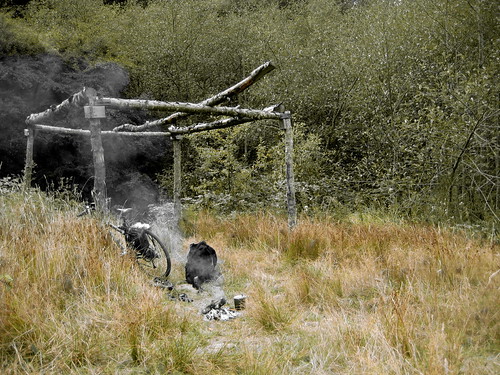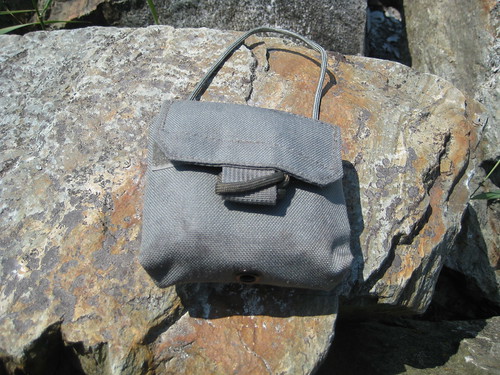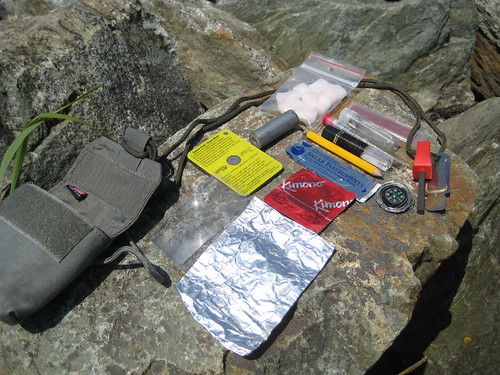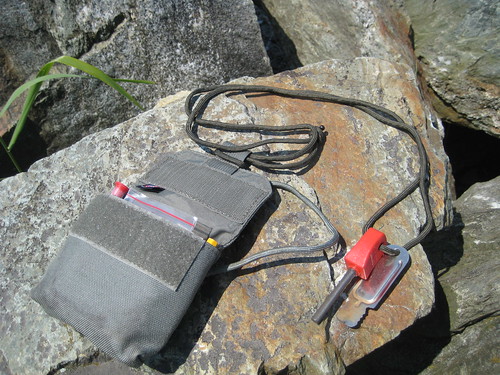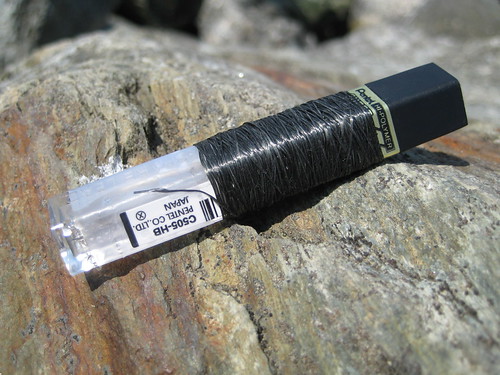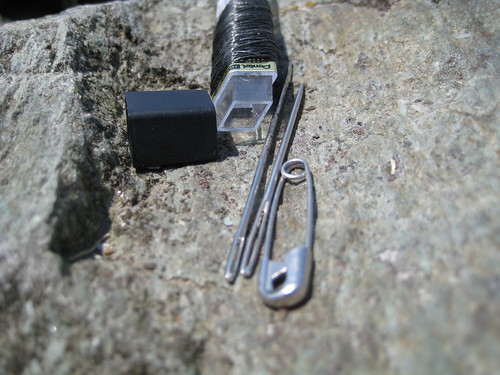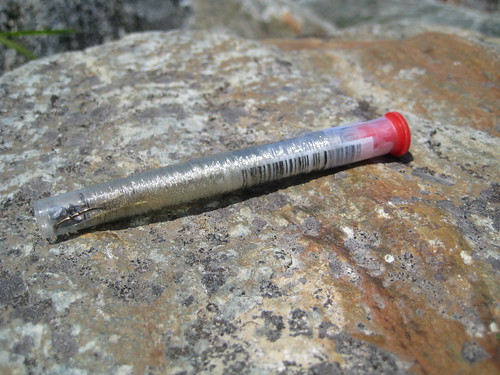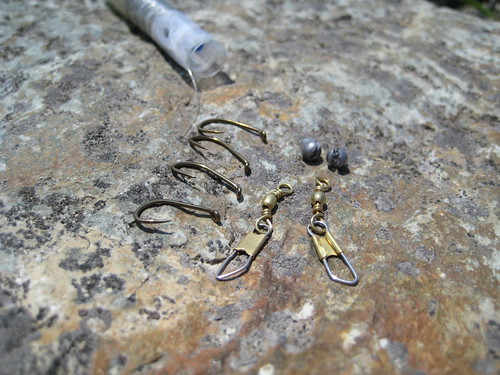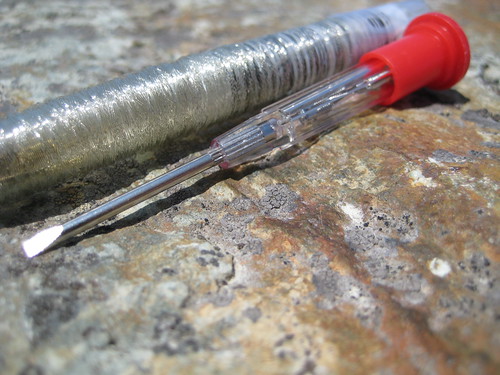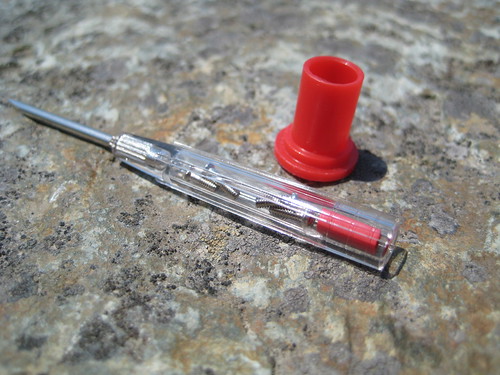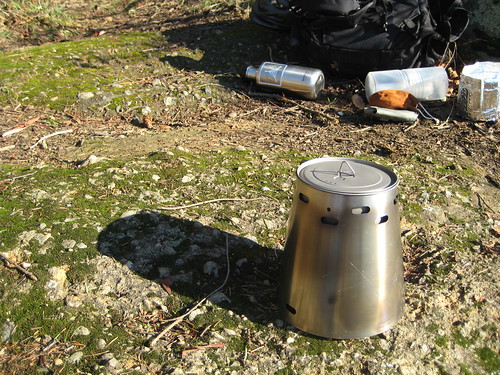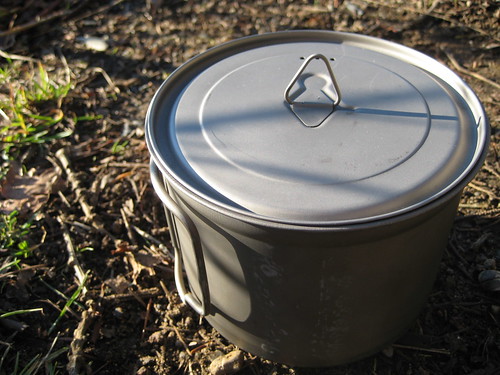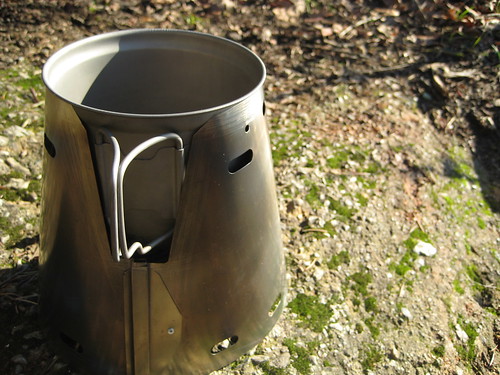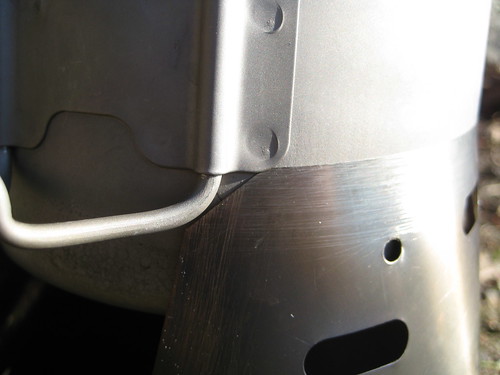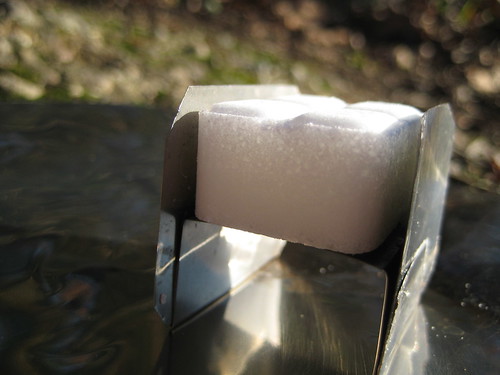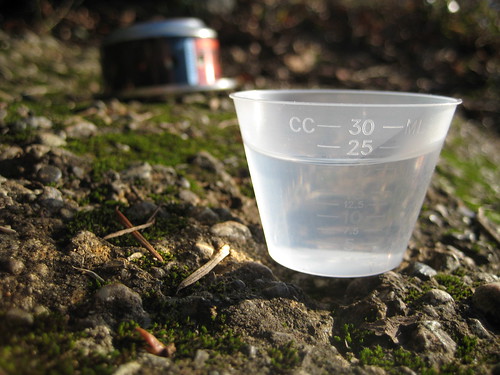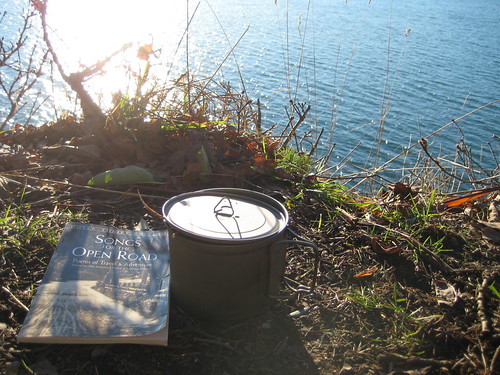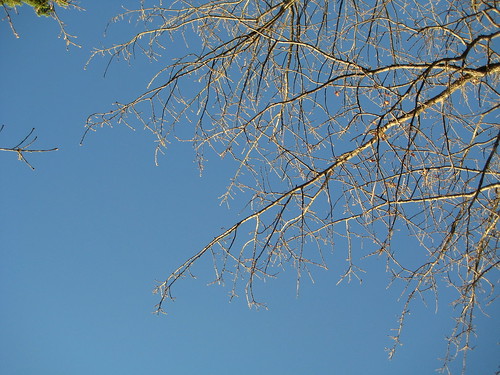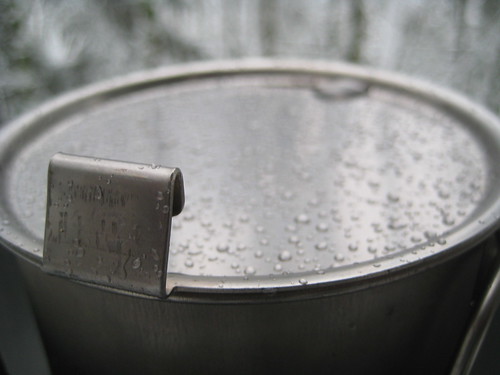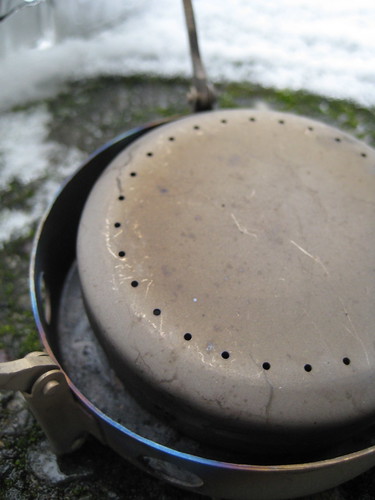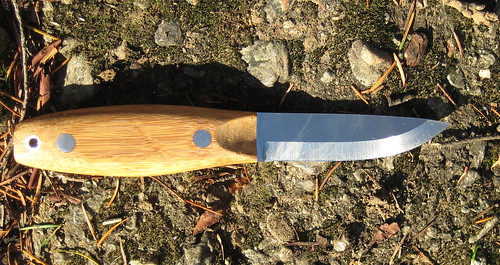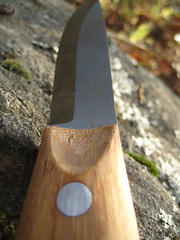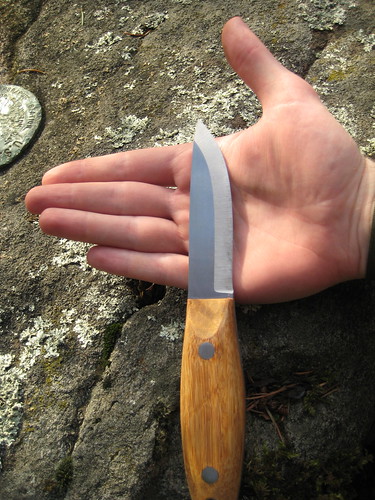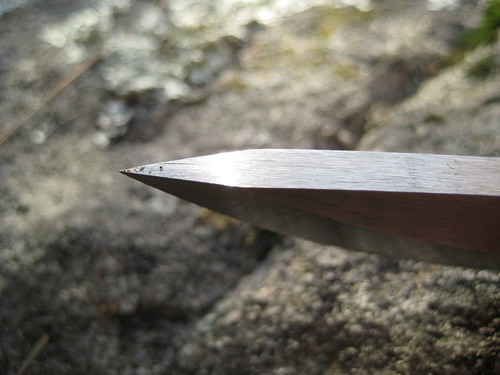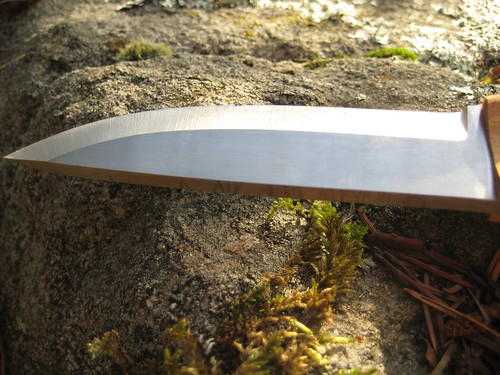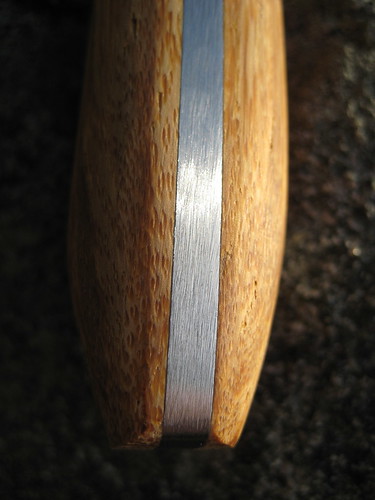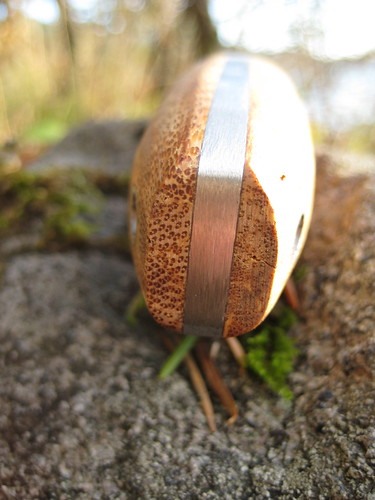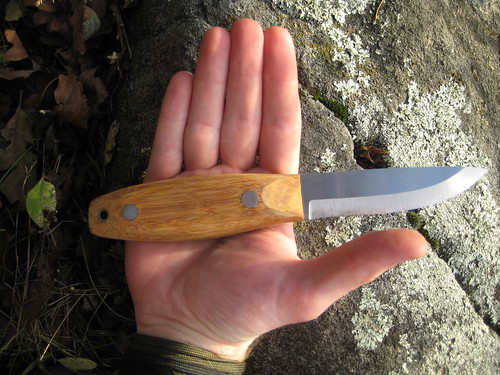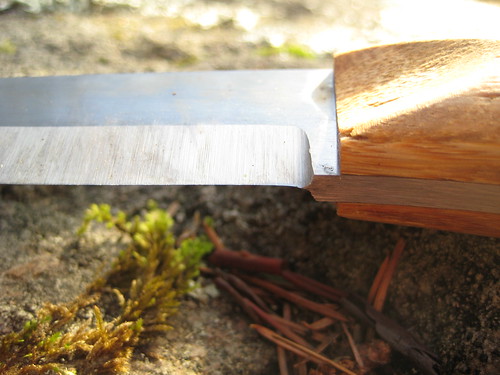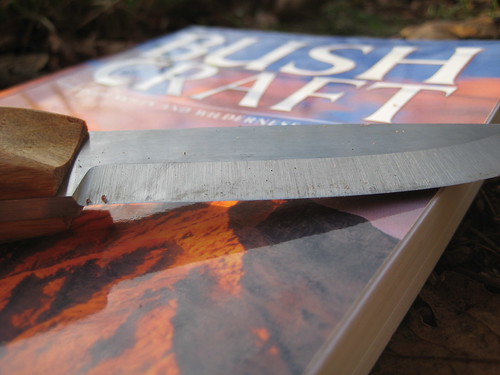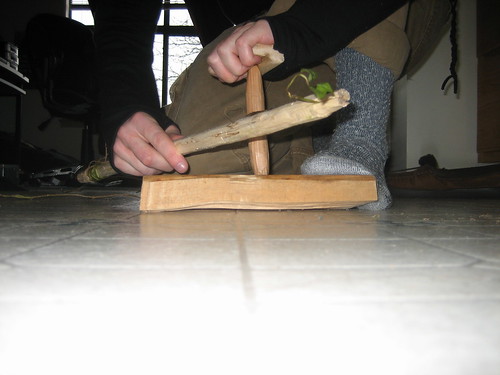You are currently viewing all posts tagged with fire.
Wilted Nettle
A lazy day of doing not much of anything sometimes makes me feel guilty. It requires that some evening activity take place – something which gives one the satisfactory feeling of accomplishing something of use during the block of waking hours. Today I chose to spend the evening in the woods. I thought I might practice some knife skills, or just sit and read a book. Arriving at my spot I was unpleasantly greeted by a thick swarm of mosquitoes, greatly annoying me and foiling my plans for peace. I decided to start a small fire with a bit more green wood than usual. The smoke from a fire usually drives mosquitoes away and the green wood would put out more smoke than dead wood. When I was out collecting wood, I noticed a large patch of Stinging Nettles in the gully below where I was. The two thoughts of Nettles and fire brought to my mind an episode of Wild Food where Ray Mears picked a few fresh Nettles and wilted them over the fire to neutralize their sting and improve the flavor. I eat a lot of Nettle raw, crushing the leaves to break the needles and get rid of the sting, but I thought I might try this new method.
After the fire was going (and the mosquitoes buzzing off elsewhere), I put a small measure of dead wood on a corner of the fire to get a bit more flame than the smokey green wood was providing. This accomplished, I went back to the gully to collect a few stalks of nettle and return them to the fire. It took only about 15 seconds of holding one plant over the flame for it to become limp and drooping. I tested it a bit with my fingers to see if the sting had been neutralized. It had. Tearing off a bit and munching it around a bit in my mouth, I was greeted by quite a surprise: these wilted Nettles were, without doubt, the best Nettles I had ever tasted, perhaps even being the best wild weed I had ever enjoyed! I ate about a dozen tall plants, until I was quite satisfied with my evening snack. Occasionally I would leave a stalk hovering over the flame a bit longer than needed, but that would impart to the leaves a slightly toasted flavor, which I also found to be agreeable.
I’ll certainly be enjoying wilted Nettles again. It’s a bit more trouble than just eating them raw, but, even on the move, it takes very little time to start a small fire and prepare a few picked plants in this way. The improved flavor greatly pays back the small investment in time.
Possibles Pouch
My possibles pouch began as being simply a Doug Ritter Pocket Survival Pak. The Survival Pak comes in a waterproof envelope that is meant to be carried in a pocket. I prefer a belt-mounted solution, so I ditched the waterproof envelope and moved the contents to a TAD Gear SERE SP pouch. The SERE pouch has velcro webbing on the back, which allows it to be mounted to be mounted to any sort of belt or PALS webbing.
When using the possibles pouch, I’m often traveling with my Kifaru ZXR. The ZXR is built upon Kifaru’s WrapTech Plus Suspension system, one of the primary components of which is the belt. The belt is a very thick, wide belt that is designed to work with the anatomy of the body and allow the user to comfortable carry obscenely heavy loads. The design of the ZXR’s belt makes it unpractical to have many pouches mounted to your own pants belt. Because of this, I didn’t want to actually mount the SERE pouch to my belt itself, but instead mount it so that it dropped down a bit below my waist, thus not interfering with the ZXR belt. To accomplish this, I simply tied a short loop of paracord through the pouch’s webbing. To mount the pouch, I pull the loop through the backside of my belt and run the pouch through the loop. This allows me to both don and doff the pouch without removing my belt.
The contents of the pouch have changed since I first removed them from the waterproof envelope. The Doug Ritter Pocket Survival Pak still forms the base of the pouch, but I’ve added and removed other items to cut down on redundancy and better compliment the other gear that I carry. I also don’t intend the possibles pouch to be strictly a “survival” item. All of the pouch’s contents have utility in a survival situation, but some of them are not intended explicitly for that.
The contents are as follows:
- Ferrocerium rod, striker and paracord
- Duct tape (26" x 2")
- Pencil
- Aluminum Foil (3 sq. ft.)
- Condom
- 2 match strikers
- 8 Coghlan's Emergency Tinder
- Sterile stainless steel surgical blade
- 20mm compass
- Stainless steel utility wire (6' of .020")
- Signal mirror
- Magnifying lens
- 4 large safety pins
- Repair kit
- Fishing kit
The components that remain from the Doug Ritter Pocket Survival Pak are the duct tape, pencil, safety pins, 20mm compass, stainless steel utility wire, sterile stainless steel surgical blade, magnifying lens, signal mirror, and aluminum foil. The other items I’ll cover here.
Ferrocerium rod, striker and paracord
This is a standard Light My Fire Scout firesteel and striker. It is not my primary firesteel, but a backup that I can be sure of always having securely attached. You might have noticed that the paracord that I use to secure the rod and striker to the pouch is rather long (about 3.5’). Paracord, of course, has hundreds of uses, so carrying a bit more of it than is strictly necessary isn’t always a bad idea. But the primary reason for the length of this particular piece of cord is that I can use it as a bow string on a fire-bow set.
Condom
This is just one standard latex condom. It can be used as a water carrier, a makeshift glove for a few fingers while taking care of a wound, a barrier to help stop the creation of a new species of half humans half wood nymphs, or utilized in the creation of emergency balloon animals.
Match Strikers
REI Storm Proof Matches always come with 2 spare strikers sealed within a piece of plastic. I find that so-called “strike anywhere” matches can be hit and miss, so by carrying this, I assure myself of always having a dry, reliable surface to strike any kind of match on.
Coghlan's Emergency Tinder
This stuff is not my favorite fire starting tinder, but it does work, and I have a bit of it kicking around, so I tossed it in. They’re stored within a small waterproof bag.
Repair Kit
My repair kit, I think, is somewhat ingenious. I like it, at least. I previously carried a small leather pouch with an assortment of different needles, types of thread, and safety pins. The whole thing was far larger and heavier than I could ever justify it being, so I ditched it and started from scratch. I got the idea for this new kit from the BackpackingLight Forums.
The container is an old Pentel mechanical pencil led refill case. This is the perfect size to secure the two needles I’ve chosen to carry and the case itself is light enough to make me happy. (And it’s free.)
Around the outside of the case, I’ve wrapped a length of black Kevlar thread. When I built this kit, I just wrapped till I got bored, so I have no idea how much thread there is. Enough, I think, for any repairs that I am likely to encounter. I chose Kevlar thread as the best complement of weight and strength. Previously, I carried a bit of standard, thin sewing thread. The thinness of that thread is suitable for sewing things like clothing, but it is decidedly weak. Kevlar thread is the same thickness, not noticeably heavier, but much stronger. I also previously carried a bit of thick waxed nylon string that is appropriate for sewing things like thick leather, heavy cotton canvas, or thick nylon. This is very heavy by my standards and overkill for most repair jobs. Out of all the gear I carry, it would probably be appropriate for repairing only my Kifaru rucksack. And Kifaru rucksacks don’t fail. If by some strange happenstance it did fail, the Kevlar thread would probably be strong enough to get be back home or to some place where a more permanent repair could be made.
Inside the case I carry two needles. One that is thicker and stronger than most thin needles used for the hand-repair of clothing, but still small enough to qualify as small in my eye (just under 5mm in length and thin enough to not punch overly large holes in a thin cotton material). I believe this is the needle that comes with the Doug Ritter Survival Pak, but I could be wrong. The other needle is slightly longer (about 6mm) and has a slightly thicker head, making it more appropriate for heavier material. (I believe this one is technically a sail maker’s needle, but I could be wrong. I have a variety of different needles I’ve picked up over the years and lack the expertise to be able to identify their intended purpose.)
Also inside the case is a small safety pin. The purpose of this is actually just to take up more area inside the case so that the two needles don’t bounce around and make noise.
This repair kit, along with the 4 large safety pins also carried in the possibles pouch, makes for a very small and lightweight repair kit that is able to tackle any of the problems that I may encounter. In addition to this, I also carry a half dozen safety pins of a varying sizes and a couple spare buttons within the rucksack itself. The guts of paracord and the floss in my toiletry kit can also be appropriated as thread.
Fishing Kit
My fishing kit is actually a combination fishing kit and glasses repair kit. An odd combination, you say? I agree.
I am dependent on my glasses, so I have always carried a glasses repair kit. Such kits are available in any drug store in the country and usually consist of a small tube that contains a few of the small screws that most glasses use, a small screwdriver to match, and a couple spare rubber nose pieces.
A year and a half ago I purchased a new pair of glasses that happen to have plastic nose pieces integrated into the frames. Recently, I was going through the possibles pouch, rethinking each item, and came upon the glasses repair kit. I opened it up and was shocked – shocked, I tell you – to discover that it contained two of those small rubber nose piece replacements. With my new glasses, these were completely useless to me. I had been carrying around an extra 2 grams (or so) all this time! I disposed of the offending pieces and felt better immediately.
But then I looked at the tube and its contents and decided that it really was a waste of space. The tube was far too large for the spare screws and screwdriver that it now contained. I shrugged, moved on to looking at the rest of the contents of the possibles pouch, and then had a stroke of brilliance. I would turn the glasses repair kit into a fishing kit!
It follows on the same principle as the repair kit.
Around the outside of the tube, I wrapped a length of 4 lb monofilament fishing line (“ultragreen” in color). Again, I did not measure the length, but it is plenty for such an emergency kit.
Inside the tube, I placed 4 small hooks, 2 split shot, and 2 snap swivels. This is clearly a very minimalist fishing kit, meant for emergencies only, not for when one intends to actually catch fish for a main form of sustenance, but I have used it. It does work.
This particular glasses repair tube is well-suited for such a kit because the lid for the tube is the screwdriver itself. The top of the screwdriver can then be removed, exposing the inside of the hollow handle. It is in here that the spare screws are stored. This allows the glasses repair bit to be separate from the fishing bit.
It should also be noted that the fishing line wrapped around the outside can also be used as repair thread.
Gear List
I have refrained from posting gear lists from my travels here mostly out of laziness, but partly because of a fear that they will be taken as absolute. The gear that I pack varies greatly from trip to trip. The type of travel, duration, terrain, and anticipated weather all factor into what I pack. On top of this, I always experiment with different gear and different configurations, seeking the best of both. Thus, my gear will differ even on nearly identical trips.
I should also note that I pack with an eye towards preparedness. That is to say that, for me, the only difference between 3 days and 30 days is the amount of food, and I’m not going to be carrying 30 days worth of food, anyway.
Still, people have expressed interest in what I pack, and I know that I do appreciate it when others whom I respect post their pack lists. So, here is the list from my last trip. The trip was 7 days long, and included about 85 miles of travel on dirt trails, paved roads, and bushwhacking. The route was never what I would call true wilderness or backcountry, meaning that I was always within one days walk of an urban area – and by urban I mean what is probably rural by most standards. The route also took me directly through small towns, which allowed me to restock on food.
I performed the trip over the last week of March. Days got up to around 45 degrees Fahrenheit, with nights around 35. Days were unusually dry (which meant it misted constantly, but didn’t actually rain). During the night, it did rain, but not terribly hard. On the first night, which was at about 1700 feet, it snowed. (The rest of the hike was through valleys and along the coast, so the elevation was well below 1000 feet.) In all, this pack list is a good representation of what I will choose to carry in Winter, not Spring. In the deep, dark of Winter, I will probably carry a few more layers of clothing and switch out some of the lighter garments for heavier ones, but, other than that, this list represents a more-or-less standard pack list for a one week journey in a Cascadian Winter, below elevation.
I do not have a reliable scale, so I cannot weigh my gear. All in all, I’d estimate the pack to be at about 45 lbs.
I’m compiling this list a few days after returning from the trip. I have already unpacked about half the items, so I may have missed something, but the bulk of the gear is certainly here. If you have any questions, or notice any stark absences, feel free to comment. Ideally, I would create a pack list as I’m packing, before the trip. Maybe next time…
The list is subdivided into two sections: what I wore on my body and what I carried in my pack. In the pack section, I decided to separate out what was carried in the lid (called an XTL), which detaches to become a man-purse and so also functions as a sort of escape and evasion bag (or a bail-out bag for the bail-out bag) and the body of the ZXR itself. Otherwise, I have not distinguished between what is carried in the main compartment, the slot pockets, or mounted on the belt. The clothing consists of three main insulating layers: a light wool shirt, a fleece vest, and a lightweight fleece jacket. These three would, of course, alternate between my body and my pack depending on where I was and what I was doing. During most of the hiking, I wore the wool shirt and packed the other two.
Worn On Body
- Smartwool Hiking socks
- Smartwool Microweight Boxer Briefs
- Ibex Woolies long underwear bottoms
- Patagonia Capilene Level 2 long sleeve tshirt
- Nemesis Hellion neck knife
- Atwood Tactical Whistle (worn on paracord around neck)
- Railriders Versatac Light pants
- Small bandana
- Ultimate Survival Technologies Strike Force
- K & M Industries Matchcase
- Hair tie
- Bic lighter
- The Wilderness Tactical Frequent Flyer belt
- Bushcraft Northwest BCNW-O1 knife
- Leatherman Charge ALX
- Pendleton Western lightweight wool shirt
- Buff
- Filson Tin Cloth Packer Hat
- Lowa Renegade Gore-Tex boots
- Sole Ed Viesturs Ultra Cushion footbeds
Kifaru ZXR
- Kifaru XTL
- Kifaru Standard Chamber Pocket
- Rite-in-the-Rain notepad (model 393-M)
- Lens cloth
- Hair tie
- Glasses strap
- Badger Healing Balm
- Purell Hand Sanitizer
- Jetstream ballpoint pen
- Fisher space pen
- REI titanium spork
- 2x spare camera batteries
- REI keychain thermometer
- Large ziploc
- Maps (5x)
- Inova 24/7 with head band
- Light My Fire Scout Swedish Firesteel and striker
- Cell phone
- Possibles pouch (Note: I'm not going to discuss the contents of this here, as I'm rethinking it with an eye toward redesign. In it's current incarnation, the items are housed within a TAD Gear SERE SP pouch, which measures 1" deep x 4" tall x 4" wide. It began as a modified Doug Ritter Pocket Survival Pak that I wanted to mount to my belt, instead of carrying it in a pocket. Many of the items remain the same.)
- Joby Gorillapod
- TAD Gear BC-8 pouch
- Canon Powershot SD1000
- Fallkniven DC4 sharpening stone
- Kleenex pocket pack
- REI Storm Proof matches
- Maxpedition Rollypolly mini dump pouch
- Self Aid Kit (Note: I'm also not going to discuss the contents of this here. Suffice for now, it is a small, pocket-sized kit composed of items in two different small aloksaks)
- Small ziploc bag
- Ultimate Survival Technologies Wetfire cubes (6x)
- Garbage bag (8 gallon)
- Small bandana
- Platypus collapsible bottle (32 oz)
- Outdoor Research Celestial Jacket hardshell
- Integral Designs Sil Poncho/Tarp
- Kifaru Standard Chamber Pocket
- REI Peak UL Compact carbon fiber trekking poles
- Blackhawk Hellstorm SOLAG gloves
- Kershaw folding saw
- Cambelback 100oz Omega Resevoir
- MSR Hyperflow water filter
- Kifaru Paratarp
- Big Agnes Seedhouse SL1 Fast Fly Floor
- Assorted stakes (12x)
- Nite-Ize Figure 9 small (4x)
- 25ft paracord (6x)
- Kifaru Stuff Sack (small)
- Kifaru 20 degree Slick bag
- Outdoor Research Hydrolite Pack Sack #1
- Thermarest Prolite 4
- Sea-to-Summit Ultra-Sil Dry Sack (8 liters)
- Smartwool Hiking socks (2x)
- Generic cotton boxer briefs
- Ex-Officio Boxer Briefs
- Ibex Outback long sleeve shirt
- TAD Gear Merino long underwear bottoms
- REI synthetic towel, 25" x 15.5" (Note: I bought this a number of years ago and I do not know the specific model name. It does not appear to be the "MultiTowel" currently listed on REI's website.)
- TAD Gear Pathfinder fleece hoodie
- REI fleece vest (Note: I do not remember the model name and REI no longer sells it. It is made of a light-weight microfleece, with stretchy, spandex-like sides that provide a larger range of movement than a vest of all fleece.)
- Trail Designs Ti-Tri Titanium Stove System (900ml pot)
- AntiGravity Gear custom pot cozy
- Large bandana
- Food (Note: this was an assortment of trail mix, couscous, a few energy bars, 2 dry miso packets, 2 bullion cubes, a couple freeze dry meals, 2 tea bags of kukicha, 2 bags of green tea, and one chocolate bar. My journey took me through towns every couple days where I could purchase a meal and supplement my stores with fresh food such as bread, cheese, and fruit. All told, I carried roughly 3 days worth of food at a time.)
- REI Nylon Mesh Storage Sack (10" x 6")
- Small comb
- Hair tie
- Nail brush (Note: used not for nails, but for laundry.)
- Floss
- Toothbrush
- Small tube of toothpaste
- Ziploc bag
- Dr. Bronner's Magic Soap (Almond castile, 2 fl oz.)
- Kifaru Standard Chamber Pocket
- Coghlan's Emergency Tinder (6x)
- Sharpie
- Highlighter
- Pencil
- Small repair kit
- Keys
- Small plastic bag (Note: used for trash)
- Large contractor garbage bag (Note: this bag is large enough to fit over the whole pack. When traveling internationally, I use these to protect all the straps and webbing on the rucksack from the airport conveyor belts. In the wilderness, it can be used internally as a pack liner, externally as a pack cover, or as an emergency bivy.)
- Small paperback book (The Golden Spruce by John Vaillant)
- TAD Gear BC-8 pouch
- Silva Ranger CL compass
- Kifaru GPS pouch
- Garmin Etrex Vista Cx GPS device
Trail Designs Ti-Tri Titanium Stove System
I’ve had a few requests to do a review of the new stove system I’ve been using for the past couple weeks. I don’t feel like I have enough experience with it yet to do a proper review, but I snapped some photos today to let people know what it’s all about.
The system is a Trail Designs Caldera Ti-Tri Titanium Stove System. It takes the older (and very popular) Caldera Cone and combines some of the know-how of the folks at Titanium Goat to create a light-weight system that burns alcohol, Esbit tabs, and wood. And, of course, it’s made of titanium.
If you already have a pot you’d like to use, you can contact Trail Designs and have them build a cone for you. Elsewise, the Ti-Tri is available with a pot from Titanium Goat. I’ve previously mentioned my love affair with my Snow Peak Trek 700 mug/cup/pot/thing, but I had been thinking of acquiring a larger, 900ml pot for somewhat more extravagant cooking. Because of this, I decided to get the 900ml Ti-Tri from Titanium Goat, rather than have a Ti-Tri built for my Snow Peak mug.
Titanium Goat’s 900ml pot is a basic affair: handles on the body, a decent lid with a thingy on top that allows it to be easily lifted, as well as three holes for venting or draining water. Titanium Goat claims that the pot and mug weigh in at 4.4oz, which seems correct to me.
The Ti-Tri system itself comes inside of the same caddy system as does the normal Caldera. It’s basically two pieces of plastic that screw together. The diameter of the caddy is the same as a 32oz Nalgene, so it will nest in the same cups (such as the aforementioned Snow Peak 700). This is a somewhat bulky way of carrying the system, I find, but the caddy is constructed out of food grade plastic, so both pieces can double as a bowl or mug. It also does a great job of protecting all the components. So far, I’ve been packing everything in the caddy. I haven’t decided if I’ll keep doing it that way or not.
The alcohol stove that comes with the Ti-Tri is a Trail Designs 12-10 which, they claim, has been designed to “perform optimally with the restricted air flow and higher heat retained by the cone during operation.” My expertise in the design of alcohol stoves are lacking and, as I said before, I don’t feel I yet have enough experience with this system to draw a comparison between it and my Vargo Triad XE (which I also haven’t had for all that long), but the 12-10 has seemed extremely efficient so far (and much easier to light).
The Ti-Tri cone itself is made from a piece of very thin titanium foil. On either side of the cone is a rib – the smaller slides into the larger, and there’s your cone. It’s very easy to assemble. The cone has air vents on the top and the bottom. When assembled, the cone goes over the stove, and the pot nests into the top.
The pot’s lip holds it up. Even with the thinness of the cone’s material, it is a surprisingly sturdy setup. You do have to be somewhat watchful when sliding the pot into the cone, as the pot handle’s mountings will sometimes get caught on the edge of the cone’s opening. I say sometimes, but this actually happens to me the majority of the time. It’s greatly annoying.
If you’re sure to center the handles over the opening in the side of the cone, the handle mountings will not get caught.
The base is an optional addition to the Ti-Tri system to be used for wood burning. It’s simply another piece of titanium foil, slightly larger in diameter than the cone. When burning wood, you set the cone on the base, put the included titanium stakes through the holes in one end of the cone and out the other. These then support the pot higher up, allowing you to shove your fuel in the cone’s side opening.
The Ti-Tri’s third fuel option are esbit tabs, which uses Trail Design’s GramCracker. The GramCracker
This setup directs the heat for a much more efficient burn than that offered by a standard esbit stove. (The GramCracker also comes with a small piece of foil to be used as a base, but since I already carry the larger base for wood burning, I leave this smaller piece at home.) With the GramCracker assembled, the cone is placed on top, and the pot is nested just as with the alcohol stove.
The Ti-Tri also comes with an 8 oz fuel bottle and measuring cup. The measuring cup holds 1 oz and has measurements marked in various units on all sides. The fuel bottle itself is the best I’ve found for alcohol. It has a tight screw lid that prevents any leaking (unlike those little Nalgene dispenser bottles), but also provides a plug with a small hole that allows one to fill the measuring cup (or the stove directly) much easier than it is to pour without such a plug.
Today, I was planning on using the Ti-Tri as an alcohol stove. Trail Designs claims that the Ti-Tri can bring 2 cups of water to a boil with 15ml of alcohol. I’ve found that 15ml brings 2 cups to more of a simmer. For a boil, you’d want 25ml. I didn’t measure exactly how much water I poured into the pot, so I decided to use a bit over 20ml of fuel.
Tea, today, would be Doug Fir and Cedar. After pouring the the fuel from the measuring cup into the stove, I lit the 12-10 with a match, tossed on the cone, settled in the pot (after getting the handle mountings caught on the edge of the cone), and shifted my attentions elsewhere. I didn’t time it this time around, but I think it burned for a bit over 10 minutes. My water was brought to a full, rolling boil – much more than I really needed just for tea, but I was just out for a day-hike, so I wasn’t terribly concerned with fuel conservation. After the burn, I tossed the Doug Fir and Cedar into the pot to steep and settled in for some tea and poetry.
Overall, the Ti-Tri comes in at just under 10oz. It’s not the lightest or most compact alcohol stove setup, but seems to me to be extremely efficient. It’s a bit like the JetBoil of the alcohol stove world. Of course, the Ti-Tri’s primary advantage over other alcohol stoves is that it is not an alcohol stove: it’s an alcohol stove, esbit stove, and wood stove. Having three different fuel options in your pack (and at such a light weight) is quite an invaluable thing. I’m greatly looking forward to further use and testing of what has become my primary cooking system.
The Ti-Tri is a somewhat new product, but has already garnered some positive press, such as a 2008 Backpacking Light Staff Pick. I’m quite curious as to how the system’s wood burning compares to that of the Bush Buddy.
Check out Trail Design’s gallery for photos further photos of the Ti-Tri in use, including at -20 degrees Fahrenheit in the Yukon.
Today’s post brought to you by: that feeling you get when you dangle your legs over a precipice that could probably kill you. And blue skies.
Bed in the bush with stars to see, Bread I dip in the river -- There's the life for a man like me, There's the life for ever. from The Vagabond, Robert Louis Stevenson
Titanium
I love titanium. It’s so light, yet strong, and discolors beautifully when burned.
The Snow Peak Trek 700 has been with me on every foray into the wilderness for the past four years, and it’s still going strong. It’s my primary pot/mug/bowl, whether I’m cooking with a fire, canister stove, or alcohol. If I were to create a list of my top ten most valued possessions, I think this would be on it.
I’ve only had the Vargo Triad XE for a few months, but it’s quickly become my favorite stove. It’s far lighter and more versatile than the Esbit stove. I haven’t even looked at my Jetboil since purchasing the Triad. The stove burns both denatured alcohol and fuel tabs, giving it a wider operating potential than most stoves that burn only either one or the other. My experience with alcohol stoves is limited, so I can’t compare the burn efficiency of the Triad to its competitors, but I, so far, have zero complaints.
If there’s the slightest breeze out, the Triad will require a windscreen when burning alcohol (fuel tabs aren’t quite as susceptible). Vargo provides instructions and a diagram for building a windscreen yourself. I ended up purchasing a Trail Designs Vari-Vent windscreen from Anti-Gravity Gear.
BCNW-O1 Bushcraft Knife
After a long wait, the end of last week brought with it the arrival of my new BCNW-O1 bushcraft knife.
In late August, I had put aside some money for a new bushcraft knife. For quite some time, I had had my eye on a Skookum Bush Tool. Yet, over the summer I discovered Mike Lummio’s Bushcraft Northwest through his YouTube channel. One of his videos features his knife, the BCNW-O1. It has a very similar design to the slightly larger Skookum, which make it difficult for me to decide which I preferred.
The knife was listed as back-ordered on Mike’s web page, so in the beginning of September I emailed him, asking when the knives would become available. My intention was that I would purchase whichever of the two knives became available first. Mike initially told me 2 weeks. That got delayed to 2 months, due to a batch of special order knives with a sharper grind coming in first and his moving the school to a new location. Still, it was available sooner than the Skookum, so I decided on the BCNW-O1.
It was well worth the wait. I couldn’t be happier with the knife.
(The plus side of the knife being back ordered is that the money had been sitting in a savings account, gaining interest since August.)
As the name implies, the BCNW-O1 is made of O1 tool steel. O1 is a relatively high maintenance material, somewhat soft when compared to other metals such as A2, and more prone to rust if not properly cared for. But the steel can be more easily sharpened to a razor edge than others, and can strike a spark off the backspine with a piece of flint (in addition to the more common ferrocerium rod). Because of this, O1 is quite popular in many bushcraft knives, including the famed Woodlore knife.
The knife is of the classic, Scandinavian design preferred by bushcrafters. The specs, taken from the product page, are as followed:
- 5/32" (3.9 mm) thick O1 tool steel
- RC 59
- 3 5/8" (9.3cm) Scandi grind blade (grind done by Daniel Koster)
- 8" (20.3cm) overall length
- Full tang
Perhaps the most unique aspect of the knife is the handle. It’s made of bamboo “that has been processed much like micarta. The individual fibers are separated and then bound together under pressure with an industrial strength, formaldehyde-free adhesive. This material can withstand 3,000 psi and is very resistant to the elements while being made from a sustainable resource.” The handle is very smooth, lacking the unique texture of micarta. It feels more like a normal wooden handle, which I love. One of the things that I don’t think is demonstrated very well by the photos on the Bushcraft Northwest site is the size of the handle. It’s a bit bigger and chunkier than what it looks like, which provides for a very comfortable grip. It fits perfectly in my hand.
(While Bamboo can be grown and harvested sustainably, many of the processing methods that go into turning it into clothing are extremely toxic and environmentally destructive. I have no idea about the process that goes into making this handle, but I don’t figure it to be any more environmentally friendly than micarta. Maybe I’m wrong, but I think you should probably avoid any synthetic or processed handle material if you’re concerned about such things.)
In addition the the handle material, the thumb scallops that are carved into either side of the handle are rather unique. This is an excellent feature that assists in certain carving grips, as demonstrated in Mike’s video.
The knife comes with a leather Scandinavian style sheath (available either with or without a firesteel holder) made by JRE Industries. I’ve used one of these with my Mora knives for a couple years and greatly prefer them over any other style I’ve tried.
Most any bushcraft knife made today owes its design, in some part, to Mors Kochanski. Though not as well known as Ray Mears, Kochanski in generally considered to be the father of modern bushcraft. In the spirit of Schwert’s introduction to the Skookum Bush Tool in Outdoors Magazine, I’ll introduce the BCNW-O1 with excerpts from the Knifecraft chapter of Mors Kochanski’s Bushcraft.
The general-purpose bush knife should have a blade as long as the width of the palm, although blades half or twice this length are within acceptable limits. A blade five centimeters long would be an excellent survival knife except for being too small to fall and limb trees of wrist-thickness. A blade 10 to 15 centimeters long will do intricate work like carving a netting needle, yet be large enough to present a good target for a baton when cutting down small trees. A blade 20 centimeters long is a superior tool for heavy work, but awkward to use for fine work.
All general-use knives should have the blade tip close to the profile centerline of the handle. The back of the handle and the back of the blade should be on the same line. The back of the blade should not be thinned down or sharpened so that a baton can be used more effectively without being cut up. There is no advantage to a two-edged blade in bush living.
The blade should be of a good quality carbon steel, from two and a half to three millimeters thick and about two to two and a half centimeters wide. This size of blade is light in weight, yet difficult to break. The steel should be soft enough to be maintained at a shaving edge with common sharpening tools, without frequent sharpening. Such steel is found in Mora (Sweden), Solingen (Germany) or Sheffield (England) knives. Carbon, unlike stainless steel, can be used as the striker in the flint and steel method of fire-lighting. Inexpensive stainless steels have had a bad reputation with respect to producing a keen edge let alone holding it. The Mora stainless steels however, are every bit as good as their carbon steels.
The metal of the knife blade should extend for the full-length of the handle (a full tang) for strength.
The handle should be a durable, water-resistant material that can be shaped to the user's hand if necessary.
The knife should have a strong pommel that will protect the handle if the knife is driven tip first deep into wood.
The curvature of the cutting edge should extend for the full-length of the blade. This cuts well and is one of the best shapes that quickly sharpens to a razor's edge. The knife blade should have a sharp enough point to penetrate deep into wood with a minimum of effort.
The knife handle should be about as long as the width of your palm. A handle that is too thick or too thin fatigues the hand and causes blisters. The cross-section of the handle should be an oval instead of round or rectangular. An oval handle provides an adequate indication of the direction of the cutting edge and raises fewer blisters than handles with angular or rounded corners.
A guard on a bush knife is in the way and detracts from many operations. It prevents the use of a simple, secure deep sheath. Some people prefer a guard for fear of slipping forward onto the knife edge, but unless the knife is used for stabbing, the hand should never slip in this way. In all my years of instructing I do not recall an injury due to the lack of a guard.
The BCNW-O1 clearly meets all of Kochanski’s criteria for the perfect bush knife, as well as introducing new innovations of its own. Though I’ve not had it long enough to perform a full review, I am extremely pleased with the knife. It has exceeded my expectations. I can safely say that I wouldn’t trade it for any other knife.
Additional photos of the knife are on Flickr.
